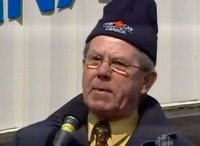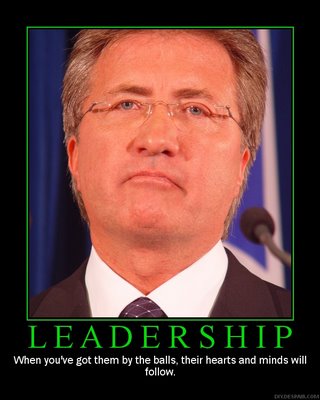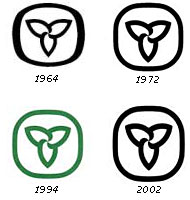[Updated 12 Oct 06; new introduction. Typos corrected
Andy Wells will be attending his first offshore board meeting tomorrow, as Wells appears to have advised local news media. Many people will be watching to see how things go.
One of the major decisions to be taken is on the development application amendment by the Hibernia partners to bring onstream 300 million barrels in the Hibernia South structures. It isn't known if that item is on the agenda for the Friday meeting or if it will be deferred for another few weeks.
The provincial government appears to be of the view that this should be a separate development with its own royalty and benefits agreement. Wells may simply stake that out as his position.
On the face of it, though, the proposal falls within the existing rules that would see the new fields brought online within the context of the original Hibernia agreement. Some recent projections have Hibernia reaching payout around 2011 which would move the provincial royalties to 30% from its existing level of around 5%. Adding the 300 million barrels to the old agreement would prolong the period in which Newfoundland and Labrador receives the second tier (30%) royalties. Until very recently, most informed opinion held that Hibernia would never see payout.
Treating Hibernia South as a new project would delay bringing the oil onstream owing to the need to negotiate royalties and benefits. If additional costs of development are added - like forcing a floating or fixed production system versus the proposal for tie-backs to the existing gravity-base structure - then the provincial government would receive relatively low royalties for a longer period before achieving the bonus of payout.
If the negotiation wound up like Hebron, there'd be no development. All of that even assumes that the oil companies would not challenge any effort to treat Hibernia South as a new project when, by all indications, it is properly viewed as an extension of the existing project.
Let's see what happens over the next few months.]
Over at the
Independent, they are in the third week of a series on the terms of union between Newfoundland and Labrador and Canada.
This week the topic was oil and gas, but unfortunately John Crosbie - one of the architects of the real Atlantic Accord, 1985 one - was
not there.
As a result, St. John's mayor Andy Wells got to dominate the panel with some input from Indy publisher Brian Dobbin and former Premier Roger Grimes. Unfortunately, the transcript of the session - edited and abbreviated down to about a half page and buried on page 14 of the print edition - isn't online.
You can get the front page
story that appears to combine raportage with editorial commentary with a whole bunch of things that
weren't in the transcript at all. If you check the transcript - as printed - the largest number of comments besides Wells' come from local writer Ray Guy. His comical, sarcastic interventions are worth reading; too bad there is no video of the session available.
Wells' comments are interesting on a number of levels, not the least of which is the recent flap over Premier Danny Williams efforts to install Wells as chairman and chief executive officer of the board that regulates the offshore oil and gas industry. That's the Canada-Newfoundland and Labrador offshore Petroleum Board or C-NLOPB.
"The C-NLOPB is an important agency in terms of trying to advocate for industry in this province," he [Wells] says.
Now that comment isn't in the transcript and of course it must be noted that the board isn't an advocacy body at all. C-NLOPB is explicitly established as the regulatory authority for the offshore oil and gas industry. Nevertheless, Wells made it clear he would prefer to see a situation in which the provincial government "would control the board" as Wells put it in the transcript. Right now, the board operates at arms length from both the federal and provincial governments.
Wells' comments on the board as presented in the transcript don't say anything like what is contained in the front pager linked above. They are infinitely more curious since Wells appears to offer a couple of contradictory points of view.
For example, Wells said in the transcript:
...The problem I've got with it is not particular to the board (C-NLOPB), it's with all regulatory agencies, it's that the regulators become the regulated. And I'm not saying they're wining and dining and handing out cheques to people, just, psychologically, the regulators become too close to the people under regulation....
If you look at the act, there's a section in there about security of supply, and once again Canadian, the national security of supply is guaranteed, not infringed on, that as far as I'm concerned, the feds should just back away and let us run it [the offshore], like Alberta runs it....They're [the federal government is] determined to keep control...
...the model for the way we handle our industry is indeed the way the Norwegians do it...but we're screwed by the federal government...
Now this could be a case of Wells having a little knowledge; it could be a case where he is working - as he apparently told the Indy - to get up to speed on the board and the issues. Of course, while he is quoted as saying words to that effect in the front-page story, Wells' comments on the board both in the transcript and with other interviews suggest he has his mind pretty much settled.
Nevertheless, it is important to realize that the key to the Norwegian model is that the policy, taxation and regulatory functions are distinct and separate. The function of the Norwegian regulatory is to enforce the laws set by the Norwegian parliament.
In that respect, the
existing structure of the C-NLOPB is
exactly the same as the Norwegian model. Both federal and provincial environmental and occupational health and safety laws apply.
There has been a problem with several federal agencies exerting separate authority over the offshore for things like environmental and shipping regulation, but within the past two years, both the federal and provincial governments on the one hand and their joint agency C-NLOPB - on the other have taken steps to reduce the regulatory overlap and establish the offshore board as the single point of contact for offshore regulation.
If Wells' comments are taken at face value, though, he is proposing something that is diametrically opposite to the Norwegian approach.
As well, the St. John's mayor seems to have missed the sections of the Atlantic Accord (1985) that provide significant control to the provincial energy minister at a times when national and regional supply are secured. Wells also misses the fairly simple point that when it comes to issues such as revenue-setting and provincial benefits - policy and taxation - the provincial government has exclusive right to determine them, exactly as in Norway. It's exactly the same in Alberta. In practice, the difference between the existing management regime and one in which the provincial government had sole legislative authority over offshore oil and gas is hardly worth noticing.
It only gets mentioned by people with their own political agendas backed by precious little concrete evidence.
Wells seems to believe that both the oil industry and the federal government are "screwing" Newfoundland and Labrador, to use a phrase Wells himself used in the session. There isn't any evidence of that, particularly on the front page story where Wells is quoted as saying "... (The companies) don't want the province to have representatives in there, on the board -— companies want to get, and keep the upper hand."
Wells should know that appointments to the board are solely the responsibility of the federal and provincial governments. Each appoints three people and the board chairman and chief executive officer is appointed jointly.
Neither order of government can veto the appointment of the other and there is no ability of the oil and gas industry - either overtly or covertly - to keep provincial representatives from sitting on the board. Wells should know that since there are likely more than a few industry representatives who would have worked strenuously to keep Wells off the board - if they could.
But since the provincial cabinet alone appointed Wells, there was no way anyone - not the federal government, not the industry - could keep any provincial cabinet from exercising its legal authority.
But lookit: if that is what Andy Wells actually said about the industry, the board and provincial government appointments, then Wells clearly doesn't know what he is talking about.
As for the fallowfield issue, it apparently never got mentioned by the Indy panel. That is, it never got mentioned unless Wells was criticizing the federal government for refusing to implement legislation giving Danny Williams the power to force the Hebron field into development on his terms.
Even there, though, the province can make changes to offshore regulations and licensing in co-operation with the federal government. Just understand, though, that there is no stomach in Ottawa for any kind of legal hammers aimed specifically at one or another of the oil companies.
The rules need to be clear and they need to be fairly and consistently applied to everyone.
Simply put, the "feds" - as some sort of mythical foreign bogeyman - aren't out to screw us.
That said, the screws are usually put to "us" very effectively by our own people who use a little information to fuel their own personal agendas. That's something we should be watching for in the weeks and months ahead.





















